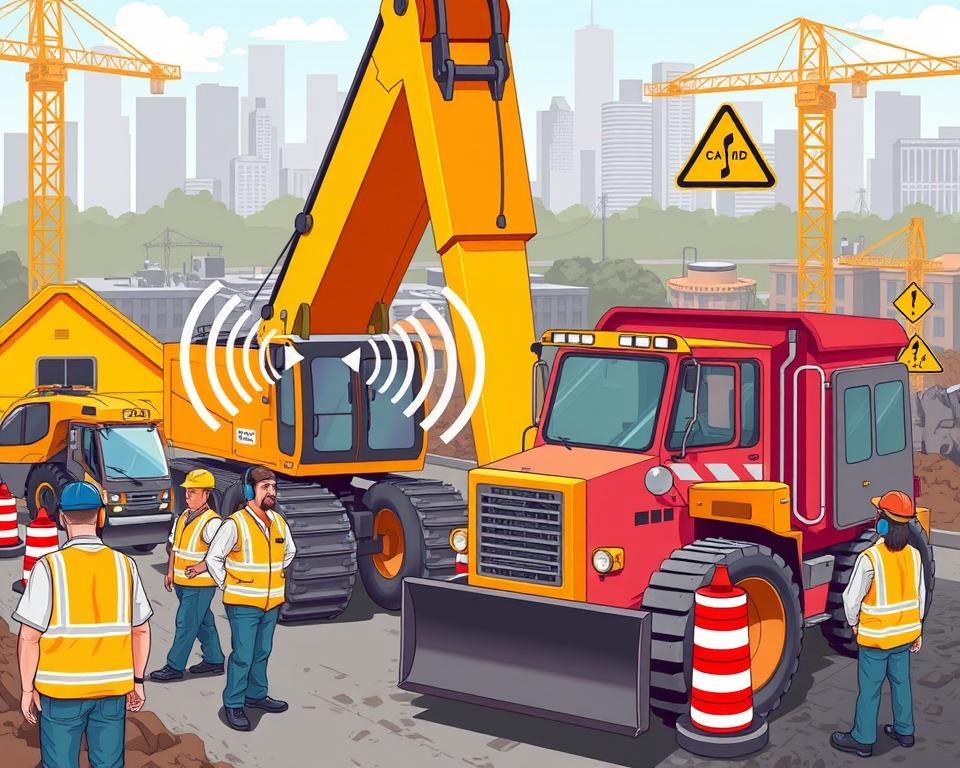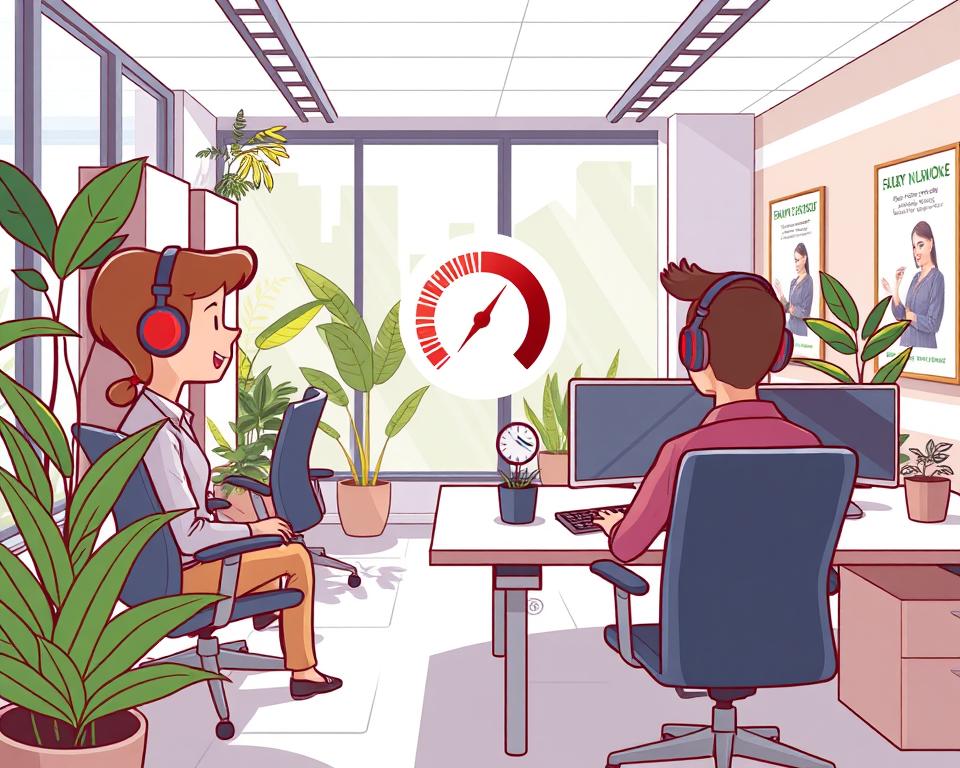In the bustling work environments across Australia, one silent offender is often overlooked—noise. But how exactly can noise control in the workplace and hearing conservation efforts go hand-in-hand to safeguard Australian workers’ hearing health? While the jarring sounds of machinery and equipment are common in professions, the creeping threat these noise levels pose is often underestimated. With exposure standards set at 85 decibels (dB) over an eight-hour period, the risks are far from minor, and the statistics are sounding the alarm; approximately 1.1 million Aussie workers are exposed to hazardous noise levels capable of causing occupational hearing loss—a preventable affliction that remains all too prevalent.
Understanding and mitigating the effects of these occupational hazards requires an integrated approach. It begins with adherence to comprehensive control measures, ones meticulously established by Safe Work Australia. But beyond regulatory compliance, there’s a moral imperative to preserve workers’ auditory health. This means introducing a robust noise control and hearing conservation strategy that envelops every aspect of workplace hearing protection—from preventive initiatives to monitoring hearing capabilities regularly, and everything in between.
Factors such as ototoxic substances and hand-arm vibration may exacerbate the risks, yet employers continue to face the challenge of implementing effective measures to mitigate them. The responsibility to protect workers from occupational hearing loss prevention does not rest solely on the provision of personal protective equipment but extends to regular audiometric assessments, which are mandatory every two years for workers in high-risk sectors. This preemptive step is crucial to catching any early signs of hearing damage and is mandated by Regulation 58 starting 31 March 2024 for those exposed to noise exceeding the standard.
Ultimately, the goal is to achieve a Noise Control Workplace where risks are not just managed but minimised—and where Hearing Conservation in the Workplace is not a mere regulation but a commitment to the well-being of each worker. The journey there is continuous, requiring unwavering dedication to safeguarding one of our most prized senses—our hearing.
Understanding the Risks of Occupational Noise
In Australian workplaces, both the scale of noise hazards and the importance of effective workplace noise management are increasingly recognized. As everyday activities ranging from the hum of machinery in manufacturing sites to the din of construction equipment contribute to common noise sources, understanding and addressing these hazards is crucial for maintaining workforce health and safety.
Identifying Common Noise Hazards in Australian Workplaces
Common noise sources vary widely across different industries, however, each can significantly impact worker health if not properly managed. From the loud operations in mining sectors that easily hover around 85 to 90 dB, to bustling factory floors often exceeding these levels, identifying these sound environments is the first step towards mitigation. Specific case studies, like those found through Spire Safety’s consultancy services, illustrate the breadth of noise hazards that businesses must navigate.
Decibels and Danger: Recognising Hazardous Noise Levels
A key metric in assessing risk is the understanding of noise exposure limits. These are well defined under regulations; for instance, exposure to 85 dB(A) over an 8-hour shift requires intervention strategies to protect worker hearing. Situations where employees need to shout to communicate even at a metre apart generally indicate hazardous noise levels that can lead to significant health issues.
Here’s a breakdown of specific limits:
| Environment | Average dB Level | Risk Category |
|---|---|---|
| General Factory | 85 – 95 dB(A) | Moderate Risk |
| Construction Site | 90 – 110 dB(A) | High Risk |
| Mining Operations | 90 – 115 dB(A) | Very High Risk |
These insights into noise exposure limits are essential for businesses in formulating their workplace noise management strategies to ensure compliance with the Work Health and Safety Act 2012 and to maintain the well-being of their workforce.

Ultimately, protecting against noise hazards is not just a regulatory requirement but a critical component of occupational health, safeguarding employees against hearing loss and other auditory complications that can arise from noise exposure.
Noise Control and Hearing Conservation in the Workplace
In the face of increasing industrial noise, implementing effective noise control and hearing conservation strategies have become paramount for Australian workplaces. This article delves into various approaches and standards necessary to reduce noise exposure and safeguard employee hearing health.
Key Strategies for Noise Reduction in Australian Industries
First and foremost, employers are tasked with adopting rigorous noise reduction strategies. The foundational step involves a comprehensive assessment of the noise levels within the workplace. This includes identifying equipment and processes that exceed the national exposure standard of an 8-hour average of 85 dB(A) and a peak noise level of 140 dB(C). Following this, implementing modifications to reduce these levels is critical, ranging from upgrading to quieter machinery to redesigning workflow to minimise noise creation.
Moreover, Australian companies are encouraged to engage in ‘Buy Quiet’ programs, which focus on purchasing and using equipment with lower noise emissions. This not only contributes to immediate noise reduction but also builds a long-term culture of hearing conservation.
The Hierarchy of Noise Control Measures
The hierarchy of noise control measures provides a systematic approach to managing workplace noise. This begins with elimination of the noise source and ends with personal protective equipment (PPE) as a last resort. Between these extremes, substitution (replacing noisy equipment with quieter alternatives), engineering controls (including installation of sound barriers and anti-vibration mounts), and administrative controls (such as scheduling work to minimize exposure time) play significant roles.
Employers must also ensure that, when noise exposure cannot be sufficiently controlled by these methods, effective personal auditory protection is used. This must include earplugs, earmuffs, and ear canal caps, and their use should be strictly monitored to ensure they provide the necessary protection throughout the entire exposure period.
Audiological Effects of Noise-Induced Hearing Loss
Noise-induced hearing loss remains one of the most significant risks of high noise levels in the workplace, highlighting the importance of an effective auditory protection program. Continuous exposure to noise levels over 85 dBA can damage the inner ear’s delicate hair cells, leading to irreversible hearing loss. This typically manifests as difficulty in understanding higher frequency sounds, thereby complicating verbal communication.
To combat this, employers must conduct regular audiometric testing to detect early signs of hearing loss and implement appropriate interventions. Education and training on the correct use and maintenance of hearing protection are vital components of this strategy.
It is essential that these auditory protection programs are reassessed and adapted regularly to respond to any changes in workplace conditions or noise levels, ensuring they remain effective in preventing noise-induced hearing loss.
Employer Responsibilities for Hearing Protection
Australian workplaces face significant challenges in managing occupational noise and its impact on hearing health. Employers who heed the Safe Work Australia Code of Practice set the standard for safeguarding workers from the risks of hearing damage. This involves a combination of diligent noise monitoring, hearing assessments, and the appropriate use of hearing protective equipment (PPE). Here, we delve into the core responsibilities that employers must undertake to ensure a safer auditory environment.
Adhering to the Safe Work Australia Code of Practice
To combat the prevalence of industrial hearing loss, noted in about 15% of Australians, the adherence to the Safe Work Australia Code of Practice is critical. This code outlines the necessity of choosing and maintaining workplace hearing protection according to the Australian Standard AS/NZS 1270:2002. Important measures include regular inspections and ensuring the suitability of the hearing PPE to the workers and the environmental conditions. Furthermore, these protective measures become imperative when operational changes such as the installation of new machinery or modifications in workload occur.
Implementing Effective Noise Monitoring Systems
Implementation of effective noise monitoring systems forms a cornerstone of employer responsibilities. These systems help in ensuring that workplace noise levels do not exceed the recommended target in-ear noise exposure level of 80 dB(A). Regular workplace noise assessments are advised by SafeWork NSW, especially under conditions where there are significant changes in noise sources. This proactive approach is essential to determine the specific hearing assessments workplace requirements, and to manage the risk of hearing damage effectively.
Mandatory Hearing Assessments in High-Risk Sectors
Regular hearing assessments are mandated in high-risk sectors, forming a vital part of the auditory health safety strategy. These sectors often involve the use of heavy machinery and equipment which can consistently exceed noise levels of 85 decibels, potentially leading to irreversible hearing loss. To combat this, it is crucial that employers not only provide suitable hearing protection but also enforce its use rigorously. This includes training workers on the correct usage, care, and maintenance of the PPE, alongside conducting regular audits to ensure compliance and effectiveness of the measures in place.
| Aspect of Compliance | Requirements & Actions |
|---|---|
| Workplace Noise Level | Assess and ensure levels do not exceed 80 dB(A) |
| Hearing PPE Suitability | Comply with AS/NZS 1270:2002, regular maintenance and proper fit |
| Worker Training | Mandatory training on PPE usage, care, and maintenance |
| Audits and Reviews | Regular checks to ascertain effectiveness of noise control measures |

Innovative Noise Reduction Strategies and Technologies
In the realm of occupational health and safety, Australia continues to tackle the challenge of workplace noise, a pervasive hazard that cuts across various sectors. To combat this, there has been an impressive uptake in innovative noise reduction tactics, including applications of noise-cancelling technologies, which are reshaping the soundscape of workplaces. Proactive implementation of noise control technologies is evident in the modification of equipment and alterations to workplace layout; all measures striving to minimize noise at its source.
Not only are engineering controls pivotal, but the hearing protection selection process has evolved too. It incorporates an array of protective gear, from earplugs to earmuffs, tailored to diverse noise levels in work environments. Customization for comfort is key as it encourages continual use among workers, bolstering protective efforts. Advancements in noise dampening materials also significantly contribute to quieter operations. Immediate reductions in machinery noise levels, for instance, have ranged impressively from 11.1 to 19.7 dB(A), whether through the acquisition of new equipment, segregation of noise sources, or installment of soundproofing panels.
Consistent vigilance in the form of regular noise assessments – utilizing precise sound level meters and dosimeters – ensures that protection measures are both present-day relevant and fine-tuned to the spectral nuances of the workplace. These assessments aid in the calibration of hearing protection devices, which are shown to reduce noise exposure by about 20 dB(A) on average. The onus is as much on the technology as it is on education, with proper instruction being instrumental in improving device efficacy by 8.59 dB. To further culture this environment of auditory safety, becoming a Work Health and Safety Officer in Australia involves committing to these rigorous standards, demonstrating an investment in a future where hearing conservation is integral to the industrial ethos.
FAQ
What are the noise exposure standards in Australian workplaces?
Australian noise exposure standards stipulate that workplace noise levels should not exceed 85 decibels (dB) over an 8-hour period to minimise the risk of hearing damage among employees.
How are common noise hazards identified in Australian workplaces?
Common noise hazards in Australian workplaces are identified by recognising activities and equipment that produce noise levels above 70dB, which can harm hearing, and particularly those that exceed 85dB, the standard threshold for potentially hazardous noise.
What does an effective workplace noise management plan involve?
An effective workplace noise management plan involves identifying noise hazards, implementing noise reduction strategies, ensuring compliance with noise exposure limits, and promoting hearing conservation through the use of personal protective equipment and regular hearing assessments.
What are the key strategies for noise reduction in Australian industries?
Key strategies include eliminating or reducing noise at the source, substituting noisy machinery with quieter alternatives, using engineering controls such as sound insulation, and implementing administrative measures like rotating employees to reduce exposure times, among others.
What is the hierarchy of noise control measures?
The hierarchy of noise control measures consists of, in order of priority, elimination, substitution, engineering controls, administrative controls, and personal protective equipment, aimed at minimising exposure to hazardous noise levels in the workplace.
How does noise-induced hearing loss affect audiology?
Noise-induced hearing loss typically affects higher frequencies between 3,000 and 6,000 Hz first, leading to difficulties in perceiving speech and potentially causing permanent threshold shifts if exposure to high noise levels is not mitigated.
What is required by the Safe Work Australia Code of Practice for noise management?
The Safe Work Australia Code of Practice requires employers to identify hazardous noise, implement appropriate noise control measures, and provide adequate hearing protection and training to workers. It also mandates regular noise level monitoring and hearing assessments in high-risk sectors.
Which noise monitoring systems should employers implement?
Employers should implement noise monitoring systems that continuously track noise levels throughout the workplace to ensure they do not exceed the exposure limits, and are appropriate for the types of noise and the specific working conditions of their workplace.
Are hearing assessments mandatory for all Australian workers?
Hearing assessments are mandatory for workers in high-risk sectors with exposure to hazardous noise levels. The specifics of the requirement can vary depending on state or territory regulations but generally involve periodic audiometric testing to detect any hearing impairment early on.
What are some innovative noise reduction strategies and technologies?
Innovative strategies and technologies for noise reduction include noise-cancelling systems, use of sound-insulating materials in construction, development of sound-absorbing designs and enclosures, and advanced personal protective equipment that adapts to specific frequencies and noise levels.
How should hearing protection be selected in noisy work environments?
Hearing protection should be selected based on the sound attenuation ratings appropriate for the specific noise levels encountered in the workplace, and should also take into account the comfort and suitability for the worker to ensure they are worn consistently and effectively.
Source Links
- Noise
- Guidance about noise management and hearing conservation
- Hearing Conservation Guideline / Document / Policy and Procedure Library
- Industrial Hearing Loss: Signs, Causes, Risks, and Protective Measures
- Noise: Safety basics | WorkSafe Victoria
- Noise
- Hearing protection | WorkSafe Victoria
- Hearing Conservation and Noise Control
- Noise – Hearing Conservation Program
- Hearing personal protective equipment (PPE) – The facts
- Controlling hazardous noise in the workplace
- Noise Control: Hearing Protection and Monitoring – HSE STUDY GUIDE
- Interventions to prevent occupational noise‐induced hearing loss

